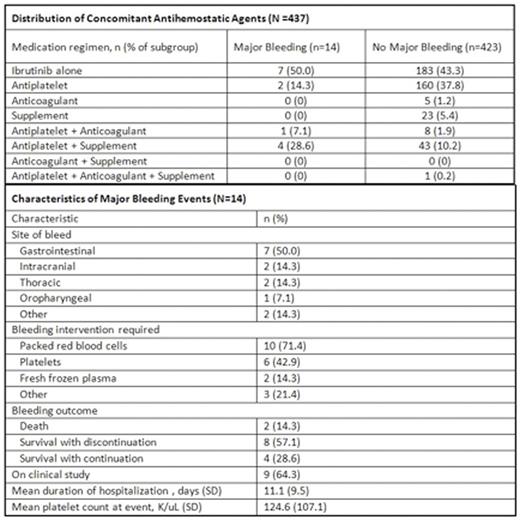Abstract
Background: Ibrutinib, an orally bioavailable small molecular inhibitor of Bruton's tyrosine kinase (BTK), is an approved therapy for chronic lymphocytic leukemia (CLL), relapsed mantle cell lymphoma (MCL) and Waldenstrӧm's macroglobulinemia (WM). Beyond B lymphocytes, BTK signaling is important for collagen-mediated platelet activation, and BTK inhibition has been associated with primary hemostatic bleeding events (Levade et al Blood 2014). Although serious bleeding events have been uncommon (1-5%) in clinical trial populations, there is limited data describing the potential for increased serious bleeding incidence when ibrutinib is co-administered with other agents affecting the clotting cascade or platelet function.
Methods: We conducted a retrospective cohort study to evaluate the incidence of major bleeding in patients receiving ibrutinib concomitantly with antiplatelet agents (non-steroidal anti-inflammatory agents, ADP inhibitors), anticoagulants (heparins, warfarin, novel oral anticoagulants), or supplements with potential anticoagulant activity (vitamin E and fish oil). Major bleeding events were identified using criteria developed by the International Society on Thrombosis and Haemostasis (Schulman et al J Thromb Haemost 2005). Patients 18-89 years of age and treated with ibrutinib for CLL, MCL, or WM between March 1, 2010 and March 1, 2015 were included. The primary endpoint of this study was the incidence of major bleeding events, but we also sought to identify risk factors associated with the development of major bleeding, focusing on potential drug interactions. Based on the historic prevalence of major bleeding in ibrutinib clinical studies, we calculated that at least 20 major bleeding events would need to be identified in order to perform blinded multinomial regression on the collected data of an estimated 400 patients.
Results: 437 eligible patients were included in the analysis. Patients were overwhelmingly male (71.4%) and white (94.8%), with a mean age of 67.1 years (range: 29-89). 53.1% received ibrutinib as participants of a clinical trial, and the remainder received standard-of-care ibrutinib treatment. The table (upper panel) summarizes use of concomitant antihemostatic agents by presence or absence of major bleeding events. Characteristics of the major bleeding events are further detailed in the lower panel. The most commonly observed concomitant antihemostatic medication was aspirin, with 147 patients (33.6%) being exposed to aspirin within the study period.
Fourteen instances of major bleeding were observed, corresponding to an overall incidence of 3.2%. These major bleeding events all occurred in CLL patients receiving ibrutinib at the standard dose of 420 mg daily. Two patients had platelet counts less than 50 k/µL at time of the bleeding event. One-half of the major bleeding events were observed in the absence of an antihemostatic medication, and 2 of the observed major bleeding events resulted in death (1 received concomitant warfarin). Fourteen patients (3.3%) in the group without major bleeding were on anticoagulation, 4 being warfarin. The most common sites of major bleeding were gastrointestinal (50%), intracranial (14.3%) and thoracic (14.3%). While most patients developing major bleeding permanently discontinued ibrutinib (57.1%), approximately one third of the patients who developed major bleeding subsequently resumed ibrutinib following resolution of the bleeding event. Subsequently, these patients did not experience a recurrent major bleeding event. The rate of major bleeding did not meet power to detect statistical differences in bleeding events when comparing concomitant therapy,
Conclusions: Our observed incidence of major bleeding is consistent with previous controlled clinical trials, suggesting similar safety profile when ibrutinib is used outside of a controlled setting. Major bleeding events were uncommon despite the frequent co-administration of antiplatelet agents. However, because we modified practice early to avoid therapeutic anticoagulation during ibrutinib therapy whenever possible, the number of patients receiving such drugs in combination was small and precludes inferences regarding safety.
Blum:Pharmacyclics: Research Funding. Awan:Innate Pharma: Research Funding; Pharmacyclics: Consultancy; Novartis Oncology: Consultancy. Woyach:Acerta: Research Funding; Karyopharm: Research Funding; Morphosys: Research Funding. Christian:Pharmacyclics: Research Funding; Janssen: Research Funding. Jones:Janssen: Membership on an entity's Board of Directors or advisory committees, Research Funding; AbbVie: Membership on an entity's Board of Directors or advisory committees, Research Funding; Pharmacyclics, LLC, an AbbVie Company: Membership on an entity's Board of Directors or advisory committees, Research Funding.
Author notes
Asterisk with author names denotes non-ASH members.


This feature is available to Subscribers Only
Sign In or Create an Account Close Modal